Sewing
box Index

History of sewing
boxes
Request current
list of available sewing boxes
| |
Antique Polychromed Chinoiserie Sewing box with embossed side handles and feet Circa 1820
Please click on images to enlarge | slide show | thumbnail index |
Reference: Sb425
Description:
SB425: Sewing box with Japanned, raised and
polychromed decoration on this sewing box depicting a
truly golden vision of Cathay. Figures relax in a garden with a distant
rock in the background and the ho-ho bird above. This is a relatively
late example of such work and it does not have an overall varnish. Note
how the gold and the colors have remained brighter than in earlier
examples. 8.5" wide. Circa 1820.
Origin: UK
Circa: 1820
Size: 21.5 cm wide: 8.5 inches wide
.
Condition: some wear
but good over all, working lock and key. see photos
|
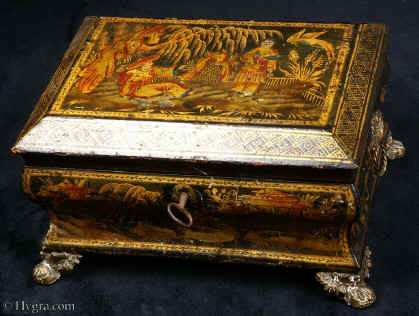
|
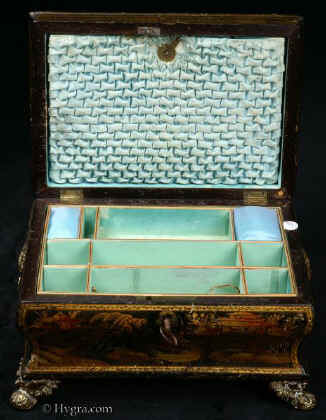
|
The inside of the lid is
covered with ruched blue silk which has a document wallet behind.
The lift out tray is compartmentalized
and covered in its original blue paper.
|
Please click on images to enlarge | slide show | thumbnail index |
|
This box is illustrated on page 25 of our book
Antique
Boxes, Tea Caddies, and Society, 1700--1880
Antigone Clarke & Joseph O'Kelly, ISBN: 0764316885
The land beyond, somewhere in the east, was generally called Cathay
and was perceived as nothing short of miraculous. Marco Polo (1254-1324)
was the first to bring the world of Cathay to the attention of Europe .
Although this work appeared centuries before chinoiserie was first
attempted in the west, the descriptions of the splendors of such places
as the winter palace of Kublai Khan with its fabulous Green Mount
garden, had a profound influence in the many attempts at recreating the
fairy tale world of the paradoxically arranged 'natural' landscape of
the east.
|
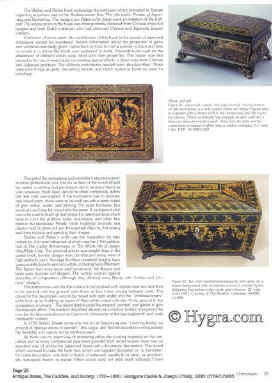
|
Please click on images to enlarge | slide show | thumbnail index |
|
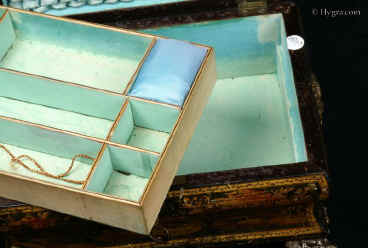
|
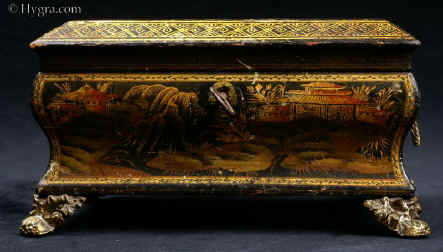
|
The
Stalker and Parker book epitomizes the confusion which prevailed in
Europe regarding anywhere east of the Mediterranean Sea
. The title reads: Treatise of Japanning and Varnishing. The
designs are Patterns for Japan-work in imitation of the Indians!
The advice given in the book was most probably deduced from Chinese
imported lacquer and from Dutch craftsmen who had observed Chinese and
Japanese lacquer workers.
Confusion
of terms apart, the contribution of this book to the spread of japanned
chinoiserie cannot be overstated. Arcane information about the
properties of gums and varnishes was freely given. Instructions on how
to coat a wooden surface and how to varnish to a mirror like finish were
explained in detail. Pigments to be used for the attainment of different
colors were listed with their properties. The reader was also tutored in
the use of metal dusts for creating special effects, a direct copy from
Chinese and Japanese practices. The different instruments needed were
also described. These were such things as quills, varnishing pencils and
Dutch rushes (a horse tail used for polishing).
The
gist of the instructions and of similar instructions given in other
publications was that the surface of the wood should be coated in
whiting and parchment size in as many layers as was necessary. Each
layer should be dried completely before the next coat was applied. If
the decoration was to incorporate raised parts, these were to be built
up with a paste made of gum arabic, water and whiting. For extra
hardness, fine sawdust could also be mixed into the paste. A rush pencil
stick was to be used to build up and shape the raised surfaces which
were to form the artificial rocks, mountains and other features in the
landscape. People, birds, buildings, animals and plants could be given a
three dimensional effect by first raising and then incising and painting
their shapes.
|
Please click on images to enlarge | slide show | thumbnail index |
Please click on images to enlarge | slide show | thumbnail index |

|
A
|
Please click on images to enlarge | slide show | thumbnail index |
Please click on images to enlarge | slide show | thumbnail index |
Please click on images to enlarge | slide show | thumbnail index |
All text and images and linked images are ©
1999-2007 Antigone Clarke and Joseph O'Kelly. If you require any further
information on permitted use, or a licence to republish any material, email us
at copyright@hygra.com
|
